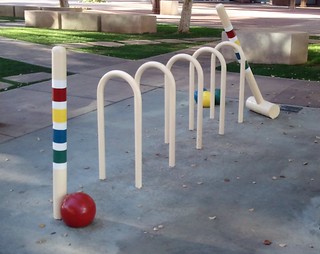 |
| Photo by Lori & Todd (cc) |
So who are those people and should they be listened to? Those people are the Association of Pedestrian and Bicycle Professionals and they have put a lot of work and thought into bike parking. In 2010, the APBP published its 2nd edition of Bicycle Parking Guidelines.
The new edition is now a comprehensive resource for practitioners and includes:
The APBP Guidelines specifically review the major types of bicycle racks, providing the strengths and weaknesses of each type, and criteria for what should be considered a good rack. Again, only one rack type was specifically not recommended:
- General bicycle parking principles and definitions of bicycle parking terms
- Guidance for both short- and long-term bicycle parking
- Elements of a good rack or locker, including specific performance criteria
- Maintenance best practices
- Sample site plans and diagrams to help avoid blunders in rack and locker placement
- Sample quantity requirements for bicycle parking to meet need by land use
- A worksheet for programming bicycle parking for a building or cluster of buildings
- Abundant images and charts to illustrate concepts and conditions
NOT Recommended: Wheelbending racks that provide no support for the bicycle frame. (P. 2-14.)
 |
| Photo by Lars Hammar (cc) |
- Two points of contact with the bicycle that supports the bicycle without the bicycle falling over;
- Ability to lock the bicycle securely to the rack (generally want to lock the frame and at least one wheel to the rack with a U lock);
- A solid construction that is difficult to cut;
- Clearance between the parked bicycles in order to avoid handlebar conflicts (handlebars or pedals of one bike protruding and damaging the adjacent bicycle); and
- The ability to be secured the rack to the ground.
There is lots more to discuss about racks:
- Location of racks (where on the property);
- Placement of the racks (how far from walls, what orientation);
- What about bicycle lockers and cages?
- Security
In addition, DC Department of Transportation (DDOT) has some very helpful information as well as some requirements. If your agency is in a commercial building in DC as a tenant, that building is obligated to comply with those regulations; if you are in a federal building, the DDOT regs can be a compelling argument for what should be done. Note how an Inverted U rack would comply with DDOT regulations, where a Wheelbender would not:
2119.1 Bicycle parking spaces shall be provided for office, retail and service uses, except for retail and service uses in the C-3-C (Medium Density Office, Retail, and Housing), C-4 (Central Business District), and C-5 (Pennsylvania Avenue) (PAD) districts.Note ♫: When GSA negotiates leases with commercial landlords for garages, GSA commonly only leases the car parking spaces in the garage. There is frequently empty space in parking garages that cannot be used to park a car - but the agency cannot use the space for a bicycle rack because the agency did not lease that empty space. When setting up a lease with a commercial landlord for garage space, make sure that the agency leases space for bicycle parking as well as car parking.
2119.2 The number of bicycle parking spaces provided shall be at least equal to five percent (5%) of the number of automobile parking spaces required under §2101.1.
2119.3 Bicycle facilities shall have convenient access from the building or structure and street or other bicycle right-of-way, be clean, secure and well lit and shall be located within a building or structure, either on the ground floor, basement, or first cellar level.
2119.4 All bicycle parking spaces required under §2119.1 shall be a minimum of two feet (2') in width and six feet (6') in length.
2119.5 An aisle five feet (5') in width shall be provided between rows of bicycle parking spaces and the perimeter of the area devoted to bicycle parking.
2119.6 If a room or common locker not divided into individual spaces is used to meet these requirements, twelve square feet of floor area shall be considered the equivalent of one (1) bicycle parking space. Where manufactured metal lockers or racks are provided, each locker or stall devoted to bicycle parking shall be counted as one bicycle parking space.
Final thought: if you apply for a Bike Friendly Business certification, the League of American Bicyclists will ask
Does your bike parking meet the security and convenience guidelines recommended by the Association of Pedestrian and Bicycle Professionals (APBP)?The APBP Guidelines are good, well thought out standards. They are rich with information that address different concerns. Take rich advantage of them, using them as a blueprint for decisions.
 |
| Photo by Lynn Gardner (cc) |
~~~~~~~~~~
This is a first installment in an attempt to create a best practices guide for federal agencies. The goal is to provide a concrete complete checklist for agencies and employees as they work to build bicycle friendly federal agencies.
This is a draft - Your feedback is encouraged.
No comments:
Post a Comment